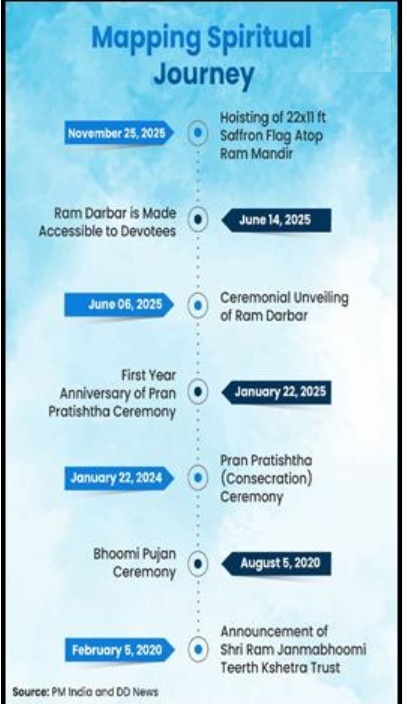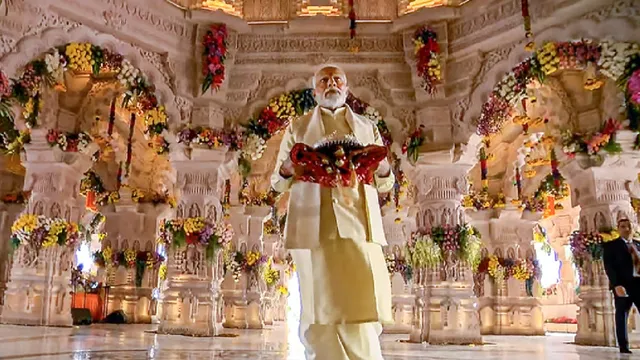- By Raju Kumar
- Tue, 25 Nov 2025 08:09 AM (IST)
- Source:JND
Ayodhya Ram Mandir Dhwajarohan: Prime Minister Narendra Modi performed the sacred Hindu ritual of “Dhwaja Arohan” by hoisting a 22-foot religious (dharmic) flag on Tuesday (November 25, 2025), marking a momentous occasion in the spiritual landscape of the country.
Significance Of Dhwajarohan
In scriptural tradition, the raising of the dhwaja symbolises the triumphant victory of dharma over adharma and serves as an open invitation to devotees around the world to participate in this celebration. The programme took place on the auspicious Panchami of the Shukla Paksha in the month of Margashirsha, coinciding with the Abhijit Muhurat of Shri Ram and Maa Sita’s Vivah Panchami, a day symbolizing divine union.
ALSO READ: Ayodhya Ram Mandir: Temple Trust Prepares For 'Dhwaja Arohan' On November 25 | See Latest Pics
At around 10 am, the Prime Minister visited Saptmandir, which houses temples related to Maharshi Vashishtha, Maharshi Vishwamitra, Maharshi Agastya, Maharshi Valmiki, Devi Ahilya, Nishadraj Guha and Mata Shabari. This followed by a visit to Sheshavtar Mandir. At around 11 am, he went to Mata Annapurna Mandir. After this, he performed Darshan and Pooja at Ram Darbar Garbh Grah, which followed by Darshan at Ram Lalla Garbha Grah.
At around 11.50 am, PM Modi ceremonially hoisted a saffron flag on the Shikhar of the sacred Shri Ram Janmbhoomi Temple in Ayodhya, symbolising the completion of the temple’s construction and ushering in a new chapter of cultural celebration and national unity. The Prime Minister will also address the gathering on this historic occasion.
ALSO READ: Temple Tourism Adds Rs 1.25 Trillion To UP's Economy; Ayodhya Leads The Boom
The right-angled triangular flag, measuring ten feet in height and twenty feet in length, bears the image of a radiant Sun symbolizing the brilliance and valour of Bhagwan Shri Ram, with an ‘Om’ inscribed on it along with image of Kovidara tree. The sacred saffron flag will convey a message of dignity, unity, and cultural continuity, embodying the ideals of Ram Rajya.
The flag will rise atop a Shikhar constructed in the traditional North Indian Nagara architectural style, while the surrounding 800-metre Parkota, a circumambulatory enclosure built around the temple, designed in the South Indian architectural tradition, showcases the temple’s architectural diversity.
The temple complex features 87 intricately carved stone episodes from the life of Bhagwan Shri Ram based on the Valmiki Ramayana on the outer walls of the main temple, and 79 bronze-cast episodes from Indian culture placed along the enclosure walls. Together, these elements provide a meaningful and educational experience to all visitors, offering deep insight into Bhagwan Shri Ram’s life and the cultural heritage of India.
A Timeline Of Events
- On November 9, 2019, in a unanimous and historic verdict, the Supreme Court of India awarded the entire 2.77-acre disputed land for the construction of the Ram Mandir, recognising the site's significance to believers across the world.

- Shri Ram Janmabhoomi Teerth Kshetra Trust received approval from the Government of India on February 5, 2020.
- The physical manifestation of this resolution commenced on August 5, 2020, when Prime Minister Narendra Modi performed the Bhoomi Pujan and laid the foundation stone at the site.
- Prime Minister Narendra Modi inaugurated the historic Ram temple after Ram Lalla’s Pran Pratishtha ceremony at Ayodhya on January 22, 2024.

